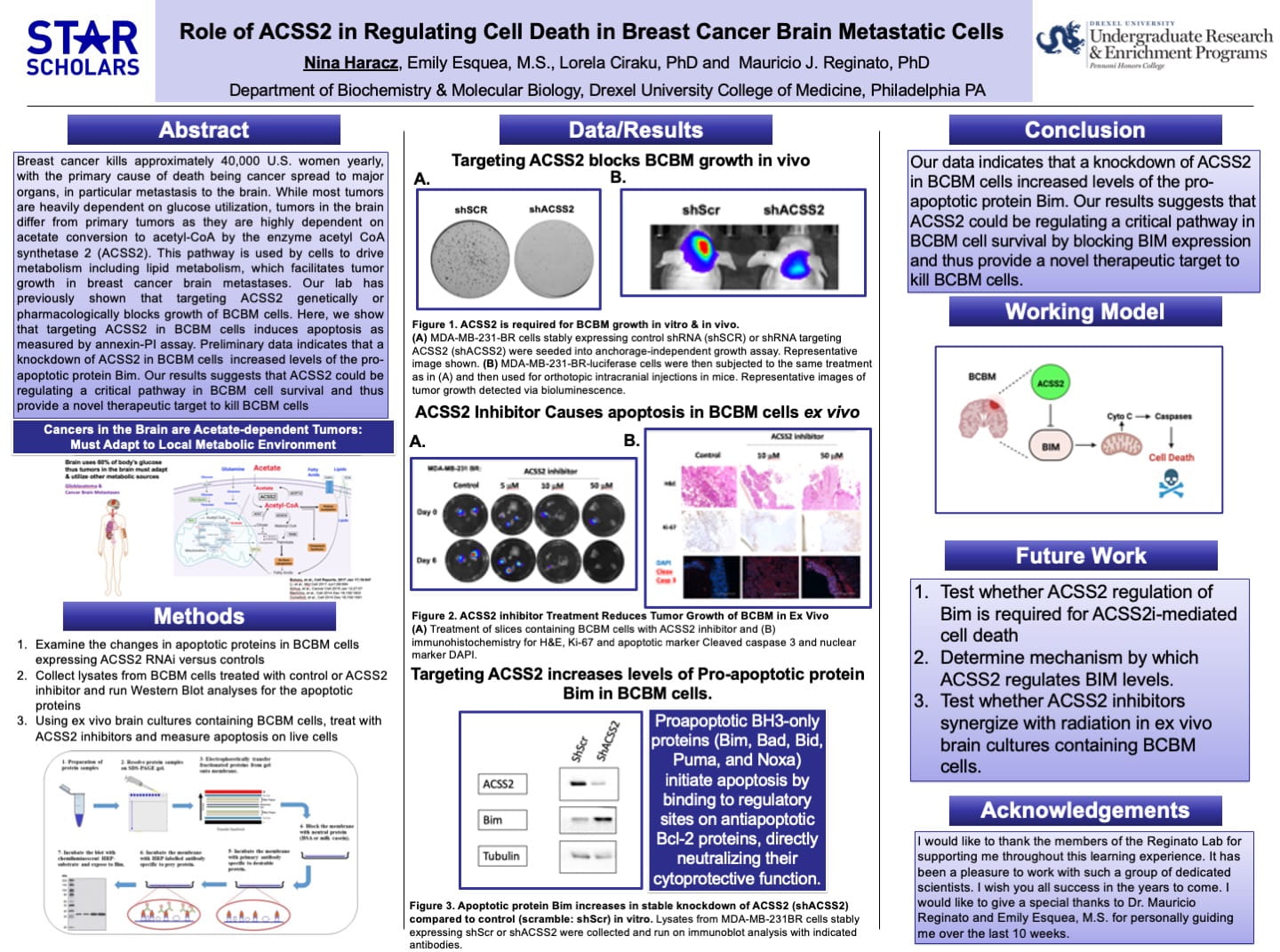STAR Scholar Scales Real-World Learning Curve in Cancer Research

Nina Haracz spent last summer doing what she called “true experimenting.”
The then-first-year Drexel University biomedical engineering student was quickly launched from biomedical engineering lab work into biochemical lab work when she conducted research through the STAR (Students Tackling Advanced Research) Scholars Program. Last summer, she worked in the lab of Mauricio Reginato, PhD, professor and interim chair in the Department of Biochemistry & Molecular Biology and director of the Graduate Program in Cancer Biology at Drexel University College of Medicine.
“I was on the lab bench every day doing research,” Haracz said. “I’m a restless person and I love puzzles, so engineering is perfect for me. But in the lab, I had to figure out what could be leading to a result I was getting and see if I can understand it. I was really lucky that I’ve kind of practiced that in engineering already, so I was able to translate that into biochem lab work.”
She had to figure out a schedule for her western blot analysis experiments, which took a few days, and develop a contingency plans if things went wrong. Adapting to experiments that turned out completely different from her theories was a struggle, but she kept at it.
Haracz was scaling a learning curve in the lab at the same time as she was contributing to research that could have real-world impacts. Reginato's lab is studying connections between breast cancer and brain tumors related to the body's amount of a protein called OGT that regulates brain acetate metabolism. About 13 years ago, his lab found that this protein is elevated in cases of breast cancer, and that OGT is also regulating lipids in brain tumors similar to how it regulates them in breast cancer by regulating an enzyme ACSS2 that controls acetate metabolism. Reginato’s lab has been testing the development of a system using inhibitors of the ACSS2 enzyme to shrink a preformed brain tumor, in a way that also doesn't kill non-tumor and non-cancerous brain cells.

Haracz searched for different markers of apoptosis, or cell death, both when using the inhibitor of the ACSS2 enzyme and a genetic way to reduce ACSS2 levels in breast cancer brain metastatic cells (BCBMs). Their hypothesis was that ACSS2 plays a key role in the critical pathway for the breast cancer cells’ survival. Haracz said those BCBM cells use ACSS2 to make acetyl-coA, which provides a different energy source for brain tumors to grow. She showed that targeting ACSS2 both stops the tumor growth and kills the cells.
This type of research experience offered through the STAR Scholar program was a big part of what drew Haracz to Drexel. She was inspired by AP Research and AP Seminar classes she took in high school that both introduced her to the ins and outs of conducting research and composing arguments based on research, respectively.
“I really wanted to get into the STAR program,” Haracz said. “I wanted to spend 10 weeks immersed in a lab. I’m a biomedical engineer, but I went straight into biochemistry, because I figured I’d be doing biomedical engineering for either the rest of my life or the rest of my time at Drexel, so I wanted to see what else was out there. Dr. Reginato struck me as someone who’d been doing this for a very long time and had been very active. He’s very dedicated to his work.”
And Haracz became very dedicated to her work, too. She wasn’t the first STAR student who came into Reginato’s lab, but she’s the first in a few years. Reginato said she picked up on the work quickly despite not having much of a background in it and was able to produce some results despite her short timeframe. In Haracz’s experiment, she genetically reduced the levels of ACSS2 to kill the BCBM cells. Now, Reginato, with colleagues in his department, can build off of that experiment when trying to develop and test compounds that can both target ACSS2 and kill specific cancerous brain cells.
Haracz has since left the lab, but said she'd love to be able to return to it. She recently completed a co-op for the fall-winter cycle working as a biomedical manufacturing engineer, helping to make biomedical engineering products and get them to customers.
“Whether or not this work is published, or it causes the cure to brain cancer and breast cancer, I got a lot out of this experience, which was definitely intimidating at first,” said Haracz. “But it was a really great environment. I felt like I was able to be super independent in this lab and when I made mistakes, I wasn't scolded but instead asked ‘What did you learn from it?’ It was true experimenting.”
Drexel News is produced by
University Marketing and Communications.

